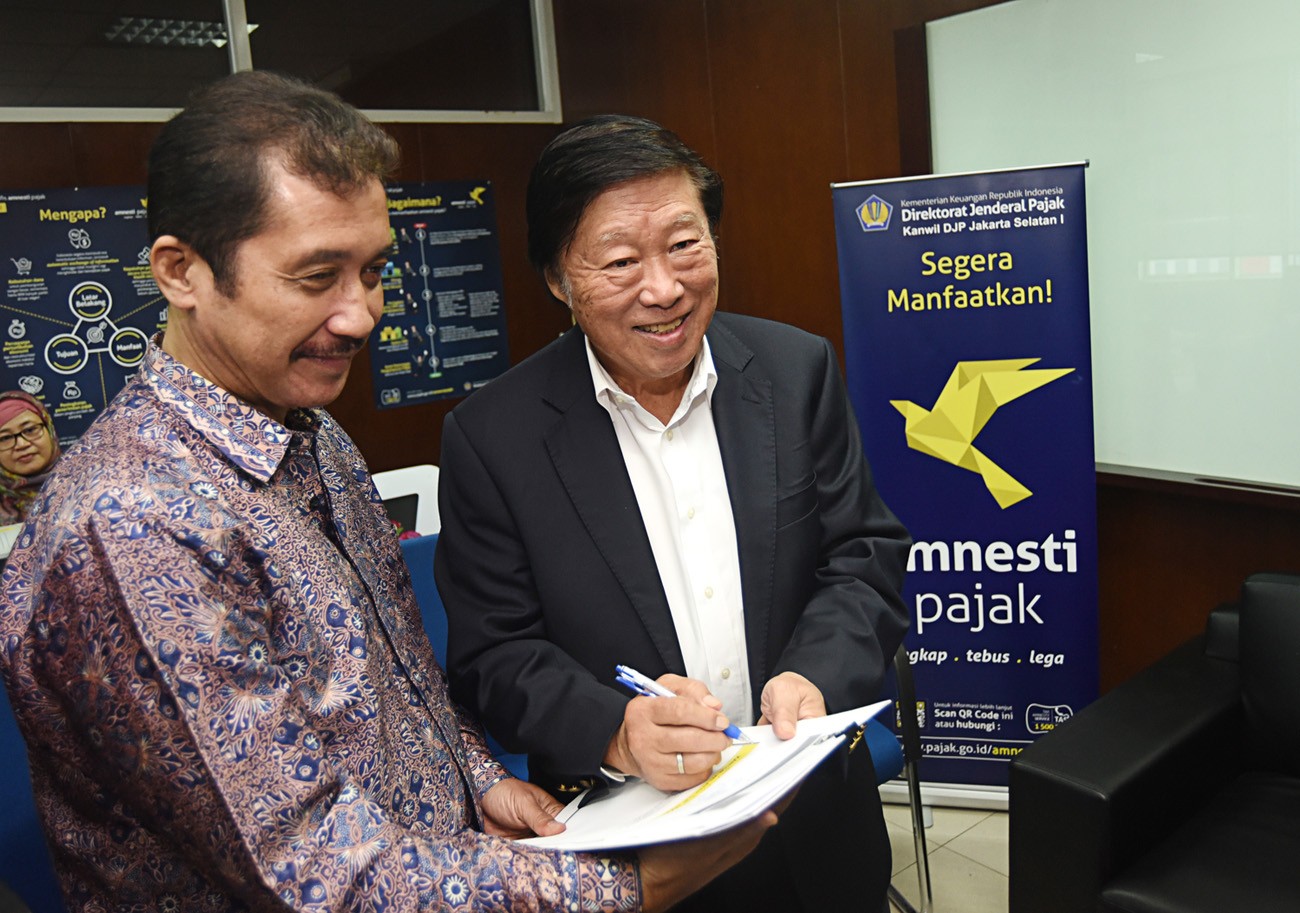Keen taxpayers, ‘big fish’ boost amnesty yields
Change Size
 A good citizen -- Tycoon Murdaya Poo (right) files a tax amnesty request at South Jakarta tax office in Jakarta on Sept. 19. (Antara/Yudhi Mahatma)
A good citizen -- Tycoon Murdaya Poo (right) files a tax amnesty request at South Jakarta tax office in Jakarta on Sept. 19. (Antara/Yudhi Mahatma)
A
fter a slow start, Indonesia has seen soaring redemption funds paid under the tax amnesty over recent days, a success the government attributes to taxpayers’ increasing awareness of the flagship program.
After kicking off in July, the nine month amnesty program is expected to collect over Rp 165 trillion (US$12.5 billion) in penalty payments and to partly plug the widening state budget deficit amid the global economic slowdown.
The program yielded sluggish results during its first weeks of implementation, with redemption payments standing at Rp 13 trillion on Sept. 15, according to the tax office’s official website. The figure, however, rose in subsequent days until it reached Rp 50.3 trillion on Sunday afternoon, with declared assets standing at Rp 1.8 quadrillion. Asset repatriation, meanwhile, amounted to Rp 92.6 trillion from the government’s target of Rp 1 quadrillion.
Tax office spokesperson Hestu Yoga Saksama attributed the positive progress to increasing public participation in the program. Many taxpayers, he said, were rushing to submit applications before the first phase of the tax amnesty ends on Sept. 30. “Their participation boosts the amount of declared assets and redemption payments,” he told The Jakarta Post on Sunday.
Participation in the first phase enables taxpayers to obtain lower redemption rates compared to the second and third phases of the program.
According to the 2016 Tax Amnesty Law, the redemption rate is 4 percent for those who declare their assets and 2 percent for those looking to repatriate assets from overseas between July and September.
As of last week, a number of tycoons, such as Santini Group owner Sofjan Wanandi, James Riady of the Lippo Group and politically wired businessman Murdaya Poo, publicly declared their participation in the amnesty program.
Despite signaling a positive trend, recent amnesty figures have faced public scrutiny, especially after the tax authority changed the way it reports such data on its website. On Sept. 15, for example, the so-called “tax amnesty dashboard” on the website reported Rp 13 trillion entering the state’s coffers from redemptions paid by taxpayers who had also submitted asset statement letters (SPH) to tax offices. A few hours later, the number soared to Rp 18 trillion, after it included data from taxpayers who had yet submitted their SPH.
The website also no longer presents incoming figures in a speedometer format showing the distance from the target of Rp 165 trillion in penalty payments. It has been replaced with a donut chart containing data on redemption payments, outstanding tax paid by taxpayers wishing to join the program and taxes collected from dropped tax investigations.
Several tax consultants contacted by the Post refused to comment on the matter, saying they had not yet checked the dashboard. Even the Finance Ministry’s taxation director general Ken Dwijugiasteadi said he was not aware of the change. “I never check the dashboard,” he said after attending a hearing at the House of Representative’s Budget Committee on Wednesday.
Yoga, however, confirmed the change, saying it aimed to provide the public with detailed data on the amnesty’s realization. “All of it is real data,” he said. Tim Condon, Singapore-based head of Asia research at ING, wrote regarding the disappearance of any reference to the full-year collection target on the Finance Ministry’s amnesty meter that, “We infer [it] is under review for downward revision.”
DBS Bank’s Singapore-based economist Gundy Cahyadi said the most important thing to watch was additional tax revenues gained from the amnesty because it was an urgent matter for the state budget.
The new dashboard will encourage people to participate in the program, said Center for Indonesia Taxation Analysis (CITA) executive director Yustinus Prastowo, who admitted he was confused at first by the new dashboard. The disappearance of the target, he added, was just a government strategy, indicating that it was no longer chasing redemption payments but more participation from the public.
Editor's note: Paragraph seven in this article has been corrected.









